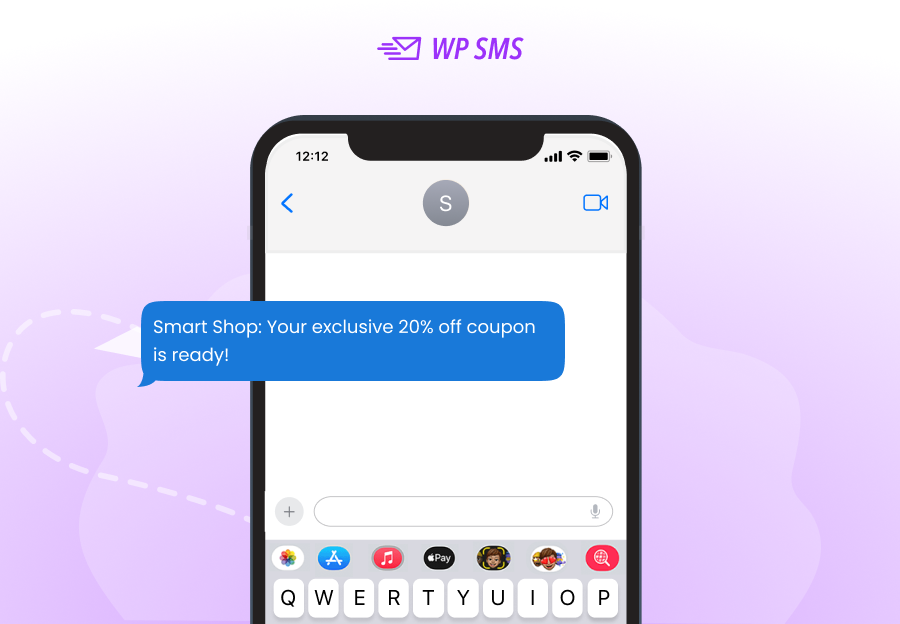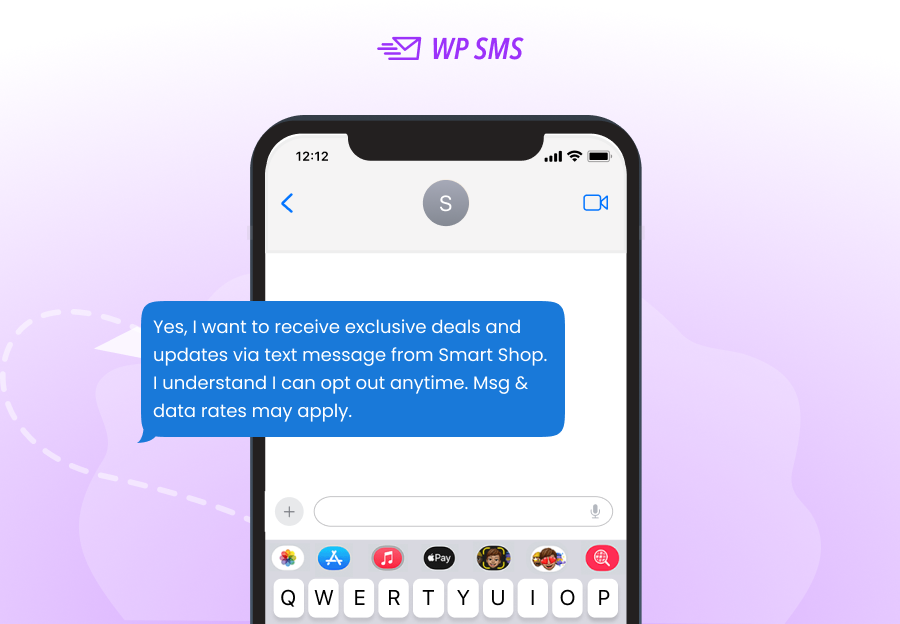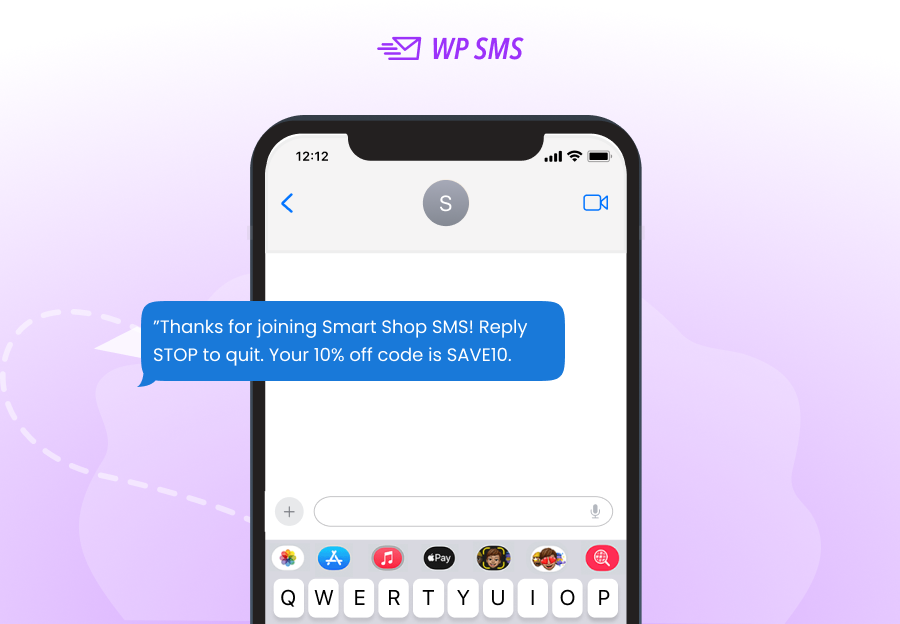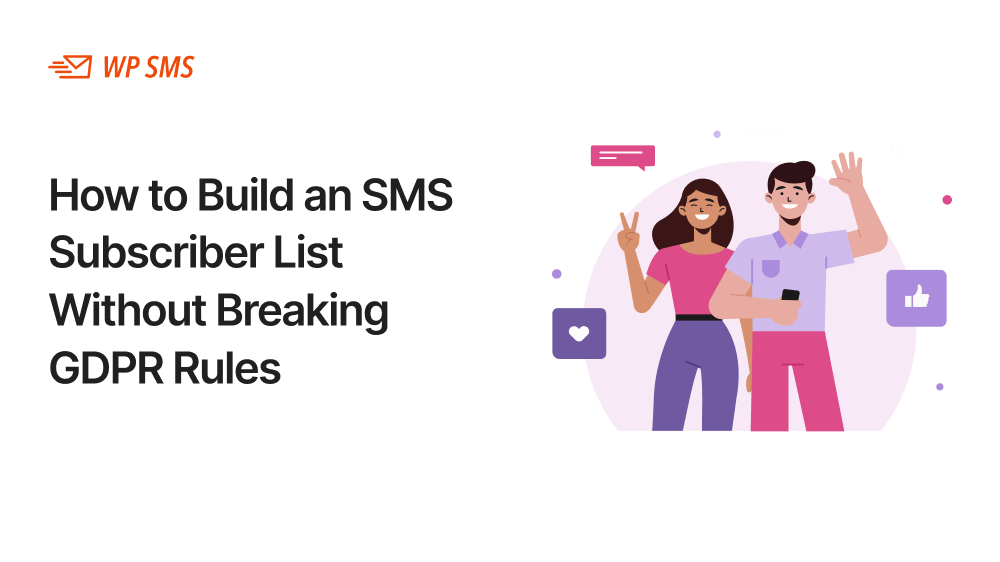As a business, it is definitely interesting for you to build a huge SMS subscriber list. There is no business that is not interested in having a large audience and if it can acquire many subscribers, it will definitely have more effective marketing campaigns, because messages get opened and read fast.
But simply collecting phone numbers is not enough. You absolutely must play by the rules, especially the strict ones like GDPR. GDPR and other similar privacy laws changed everything about collecting phone numbers for SMS subscriber lists.
It is no longer possible to buy lists or add people without their clear consent. Trying old-school tactics now is a way to get into serious legal trouble and wreck your brand’s trust. These days, people value their privacy highly.
So, does this mean building a text message subscriber list is impossible? No. The key is shifting your focus to ethical SMS list building. This means putting consent at the heart of your SMS subscriber acquisition strategy.
You can absolutely grow your SMS audience legally and effectively. It involves using smart SMS opt-in strategies and clear SMS signup forms.
In this article, we will explain in detail what GDPR compliance is. Then we explain best practices and strategies for growing your SMS subscriber list.
What Is GDPR?
So, what exactly is GDPR? It stands for the General Data Protection Regulation. Think of it as a strict set of rules created by the European Union (EU) to protect people’s personal information.
If your business holds the data of anyone living in the EU, even if you are based outside the EU, GDPR applies to you.
At its core, GDPR is about respecting individual privacy rights. Before GDPR, companies had much more freedom to collect and use personal data. Now, individuals have the right to know:
- what data you collect,
- why you collect it,
- how it will be used, and
- who it might be shared with.
They also have the right to access their data, correct it, or request that you delete it entirely.
So you cannot collect phone numbers or send marketing texts without clear and specific permission. GDPR makes consent the absolute cornerstone of any legal SMS subscriber acquisition.
You cannot assume consent; you have to ask for it directly and prove you got it. This focus on explicit permission is the foundation of GDPR compliant SMS marketing and ethical SMS list building. Plus, ignoring GDPR is not an option. Breaking these rules can lead to massive, reputation-damaging fines.
Why GDPR Is Important in SMS Marketing
Breaking GDPR rules can lead to massive fines. We are talking up to €20 million or 4% of your global annual turnover. So staying GDPR compliant is essential to avoid these financial penalties.
Beyond the fines, there is major reputational damage. Sending SMS marketing campaigns without proper consent is spam and people hate them.
It annoys them and makes them distrust your brand instantly. If you are known for sending unsolicited messages, you will struggle to build a loyal text message subscriber list.
GDPR rules actually help you build a more effective SMS list. It makes you implement privacy-friendly SMS campaigns that respect your audience and build long-term trust and loyalty.
In fact, GDPR compliance leads to much higher engagement rates for your SMS campaigns. People who opted in are far more likely to open, read, and act on your messages than those who did not.
As a result, it is very important and essential to consider solutions for GDPR compliance.
GDPR Compliance Checklist
Building an SMS subscriber list requires strict adherence to GDPR. This checklist outlines the core rules you must follow for GDPR compliant SMS marketing. In fact, these points are legal requirements when handling EU citizens’ data, including phone numbers.
Explicit Consent
GDPR demands explicit consent. This means the person must take a clear, affirmative action showing they agree to receive your marketing texts. A pre-ticked box or assuming silence means yes is absolutely not enough. They need to actively say “yes.”
Subscribers should not feel pressured or tricked into signing up and the consent must be given freely in order to be valid. Your subscribers need to understand exactly what they are agreeing to – that they will receive promotional text messages from your business.
In addition, you cannot bundle consent for your SMS list with acceptance of your general terms and conditions or privacy policy. Signing up for SMS must be a separate, distinct choice the user makes.
Plus, the language used when asking for consent must be crystal clear. Avoid jargon or legalese. Use simple phrases like “Sign up for exclusive deals via text message” and explicitly mention marketing.
Separate Consent for Each Marketing Purpose
Getting consent for one type of message or communication does not mean you have the right to send everything to the user.
Consent for email marketing does not automatically mean consent for SMS marketing. Plus, when you collect phone numbers for delivery SMS updates, the consent you obtain must be solely for sending these kinds of messages and you cannot assume that you can send SMS marketing campaigns to your users.
If you plan to use SMS for different types of messages, you ideally need separate consents for each distinct purpose.
Additionally, bundling all permissions together is not transparent and violates the principle of specificity required for permission-based SMS outreach and your SMS signup forms should clearly state the specific purpose of the messages.
For example, “Subscribe for weekly discount alerts via SMS” is clear. So you must avoid vague wording like “Receive updates”. This does not inform the user precisely what kind of texts they will get.

A practical solution is this: After you have obtained explicit permission from your users for each marketing purpose, you can put them in a group so that when sending SMS messages, you can only send each SMS to the group you are authorized to.
If you use the WP SMS plugin to send SMS messages, then you can easily segment your customers and easily send specific SMS messages to each group.
Maintain Records of Consent
You must be able to prove the permission from your subscribers. So always record how and when you obtained the explicit consent. This proof is crucial if questions arise later about your GDPR compliant SMS marketing practices.
More precisely, you should record:
- Who gave consent: the subscriber’s identity, usually linked to their phone number
- What they specifically consented to: e.g., “marketing SMS about new products”
- When they consented: date and time
- How you obtained it: e.g., via a specific website form, text keyword
- And what information they were shown when they consented: a copy of the form or message text.
Send During Daytime Hours
Respecting your subscribers’ time and privacy is crucial. Although GDPR itself does not have specific “quiet hours” for sending SMS, other relevant EU laws are strict in this regard.
A very common and safe window to follow is avoiding sending messages before 9:00 a.m. and after 8:00 p.m. in the recipient’s local time zone.
However, here is a list of countries with the quiet hours you must follow.
| Country | Quiet hours |
| Austria | 8 PM – 8 AM |
| France | 8 PM – 8 AMAll SundaysAll public holidays |
| Germany | 8 PM – 8 AM |
| Ireland | 8 PM – 8 AM |
| Italy | 9 PM – 11 AM |
| The Netherlands | 10 PM – 9 AMSaturdays: 4 PM – 10 AMAll SundaysAll public holidays |
| Spain | 9 PM – 9 AMAll weekendsAll public holidays |
| Switzerland | 8 PM – 8 AM |
| United Kingdom | 8 PM – 9 AM |
Age Restrictions
GDPR has special protections for children’s personal data. You generally cannot process the personal data (like a phone number) of anyone under the age of 16 for marketing purposes without verified parental consent. Some EU member states might set this age as low as 13, so you need to know your target locations.
Ignoring age restrictions can lead to severe penalties. You can only collect phone numbers for SMS marketing from appropriately aged individuals, or with verified parental permission. It is a non-negotiable aspect of SMS marketing compliance and protecting vulnerable users.
Clear Disclosure
Transparency is key under GDPR. Before anyone gives consent, you must clearly tell them exactly what they are signing up for. This means your SMS signup forms or must plainly state:
- Who you are (your business name).
- That they are agreeing to receive marketing text messages.
- What kind of messages will they receive (e.g., promotions, discounts, alerts).
- How often they might expect messages (e.g., approx. 4 per month).
- That message and data rates may apply.
- How can they easily stop messages at any time (e.g., “Reply STOP to unsubscribe“).
Your disclosure needs to be upfront, easy to understand, and impossible to miss, so do not bury this information.
Be Frank About Data Usage
GDPR requires honesty about what you do with the personal data you collect. When someone gives you their phone number for your subscriber list, you must be clear about how you will use it.
Do not collect data under false pretenses or use it in ways the subscriber would not reasonably expect.
In fact, your clear disclosure (as we explained before) must include information about data usage. Tell subscribers if you will only use their number to send the marketing texts they signed up for, or if you might also use it for other purposes (like profiling or sharing with third parties).
If you share data, you must name those third parties and explain why.
Collect Only Necessary Data
Only ask for what you absolutely need. When building your SMS subscriber list, this means collecting just the phone number for sending text messages.
Do not ask for extra details like addresses, unless they are strictly essential for the specific SMS service you are providing and you have explicit consent for that specific purpose.
In addition, asking for unnecessary information increases the amount of sensitive data you are responsible for protecting, and it raises your risk if a breach occurs.
For instance, for basic promotional SMS, the phone number is almost always sufficient. If you later need more data for personalized offers, you must ask for separate, specific consent and clearly explain why you need it and how it will be used.
Comply with International Data Transfer Rules
If your business or SMS service provider is located outside Europe, transferring European subscribers’ phone numbers requires special care under GDPR.
Storing or processing the data on servers in the US or Asia without safeguards is illegal. In fact, you need to ensure any data transfer outside Europe uses GDPR-approved mechanisms.
The most common solution is signing Standard Contractual Clauses (SCCs) with your non-EEA SMS marketing platform provider. These are pre-approved legal contracts that bind the provider to GDPR-level protections.
Protect Data
GDPR mandates that you implement strong technical and organizational measures to protect the personal data you hold.
So you should choose a reputable SMS gateway that uses robust security practices: encryption for data both in transit (when being sent) and at rest (when stored), regular security testing, and strict access controls.
Do not store subscriber lists in insecure spreadsheets or documents accessible to everyone in your company.
Plus, within your own business, limit access to the SMS subscriber list only to staff who really need it to do their job (like sending campaigns).
In addition, it is highly recommended to use strong passwords and multi-factor authentication on any systems accessing the data.
Finally, you should train your team on data security basics.
Include the Business Name in Messages
The subscriber needs to instantly recognize who the message is from. So every marketing SMS you send must clearly identify your business.
For example:
Message

Omitting your business name makes messages look suspicious and spammy.
Avoid Prohibited Content
Sending prohibited content, even to people who opted in, violates rules and can get your messages blocked or your account suspended by carriers.
Key prohibitions include:
- High-risk financial services
- Illegal products/services
- Adult content
- Hate speech, harassment, and threats
- Deceptive or misleading offers
Your messages must also comply with general advertising standards: be truthful, not misleading, and clearly identify ads.
Determine Frequency of Messages
While GDPR does not set a strict numerical limit, bombarding subscribers with excessive texts violates their consent and expectations. You must manage frequency reasonably to avoid harassment, which is prohibited. So, set clear expectations before they join your SMS subscriber list.
Your initial clear disclosure should include an estimated message frequency (e.g., “approx. 2-4 messages per month”). This helps subscribers decide if they want to opt-in.
In practice, to be able to easily implement this, all you need to do is schedule your SMS messages so that they are sent at the necessary times without worry.
If you use the WP SMS plugin to send your SMS messages via your website, this SMS marketing tool allows you to schedule messages and send them to the desired groups.
Privacy Policy Page
You must have a comprehensive, easily accessible privacy policy page, where you detail everything about how you handle personal data, including phone numbers for your text message subscriber list. It fulfills GDPR’s transparency requirement.
In addition, you must link directly to this privacy policy at every point where you collect phone numbers for SMS.
Double Opt-in (Recommended)
While GDPR technically allows single opt-in, double opt-in is highly recommended for robust GDPR compliant SMS marketing.
Here is how it works: After someone initially signs, they immediately receive an automated text asking them to confirm their subscription (e.g., “Reply YES to confirm joining Smart Shop SMS alerts“). Only after they reply “YES“, will they be added to your text message subscriber list.
This extra step provides undeniable proof of explicit consent. It ensures the phone number entered was correct and belongs to the person who actually requested the subscription.
Proven Strategies for Building an SMS Subscriber List Without Breaking GDPR Rules
The strategies below focus on ethical SMS list building by putting clear consent at the forefront. They are designed to help you grow your SMS audience legally and ensure every subscriber really wants your messages.
Website Sign-Up Forms
You can place the SMS signup forms anywhere you want, on your website: on your homepage, footer, product pages, or as a pop-up/scroll box.
But remember that it should be simple and have a clear consent checkbox.
The consent language must be explicit. Use text like:
Message

Plus, link to your Privacy Policy.
After signing up, you can send an SMS message to the subscriber:
Message

Text-to-Join Campaigns
Text-to-join (or keyword campaigns) is a direct and popular SMS opt-in strategy.
Promote a specific short code or phone number and a keyword (e.g., TEXT “DEALS” to 12345) across your marketing channels – ads, packaging, receipts, in-store signage.
When someone texts the keyword to your number, they initiate the sign-up process. Your auto-response must immediately deliver the promised value and request explicit consent.
For example:
Message

Only if they reply “Y” (explicit consent) should they be added to your main SMS subscriber list.
QR Code Opt-Ins
Print QR codes on product packaging, posters, or receipts. These should link directly to a mobile-optimized page designed for SMS subscriber acquisition with a sign-up form. This method is highly effective at events, in physical stores, or on physical products.
The landing page must clearly state the offer and collect only the phone number with explicit consent. For best results, use double opt-in SMS by sending a confirmation text.
Email List Cross-Promotion
Your existing email subscribers are a warm audience for your SMS list. So it is a good idea to promote your SMS subscriber list within your regular email newsletters or dedicated campaigns. You just need to explain the unique value of SMS (urgency, exclusivity) and how to join easily.
Plus, it is better to include a clear call-to-action (CTA) button linking to a dedicated SMS sign-up page. Then, using double opt-in SMS is highly recommended.
For example, you can send:
Message

SMS Sign-up CTAs in Social Media
Leverage your social media reach to promote your SMS list. Use clear posts, stories, pinned comments, or even bio links to drive followers to your SMS sign-up page. Highlight the exclusive benefits they will get via text.
You can run targeted ads specifically promoting SMS sign-ups. The ad should focus on the value (e.g., “Text DEALS to 12345 for 15% Off Now!“). Plus, ensure the landing page or auto-response sequence includes all necessary consent language for permission-based SMS outreach.
Example SMS after sign-up:
Message

Customer Service Opt-In Paths
Customer service interactions (phone, live chat, email support) are golden opportunities for SMS subscriber acquisition. When resolving an inquiry, agents can politely ask if the customer would like to receive helpful updates or exclusive offers via SMS.
It is crucial to remember that the agent must not add the number without explicit consent.
So if the user agrees, send an email with a link to your standard SMS sign-up form, or provide the text keyword. Never add them directly based on a verbal “yes” alone without a documented opt-in process.
Post-Purchase Opt-Ins
The checkout process and post-purchase follow-up are great moments for SMS opt-in. When customers are happy, it is a good idea to offer them to get order updates and future deals via SMS.
On your online checkout page, after payment, you can include an optional checkbox for adding to the SMS list. Or for in-store purchases, you can print a QR code or keyword on the receipt.
Offline Event Opt-Ins
Trade shows, markets, pop-up shops, or workshops are excellent for collecting phone numbers for SMS in person. Use physical sign-up sheets, digital tablets, or QR codes prominently displayed at your booth or during the event.
Then, you can send a Follow-up SMS message, like:
Message

Webinar & Live Stream Opt-Ins
When hosting online events (webinars, live streams, Q&As), promote your SMS list as a way for attendees to get reminders, key takeaways, exclusive follow-up content, or related offers. Mention it during the event, and include CTAs in the registration confirmation and follow-up emails.
Then, after signing up, you can send:
Message

Incentivize Your Users
Offering genuine value is a powerful SMS opt-in strategy for SMS list growth. People are more likely to share their phone numbers and give consent if they receive something worthwhile immediately. But ensure the incentive is relevant and clearly advertised.
Here is an example Flow:
- Customer texts “DEALS” to 12345
- Auto-reply: “Reply Y for 15% off & ongoing deals from Smart via text (4-6/mo). Msg&data rates apply. STOP to quit”
- Customer replies Y.
- Next message: “Thanks! Your code is SAVE15. Shop: http://site.com. Welcome offers coming soon!“
Conclusion
GDPR is mandatory for businesses that have users residing in Europe. So implementing GDPR compliant SMS marketing is a must. GDPR is a law to protect the privacy of users and their data, and if it is not implemented, you will be subject to heavy fines.
However, that is not all. Following these rules will also give you satisfied users who genuinely want to receive your SMS messages. In fact, ethical SMS list building focused on permission-based SMS outreach creates trust.
Therefore, by using the SMS opt-in strategies and sticking to the SMS list best practices we have covered, you can grow your SMS audience legally and ethically. Getting an explicit consent and using methods like clear SMS signup forms, double opt-in, and strategic incentives ensures every subscriber actively wants your messages, which is the goal of GDPR.
FAQs
What is GDPR, and why does it matter for my SMS list?
GDPR (General Data Protection Regulation) is a strict EU law protecting personal data like phone numbers. If you have subscribers in the EU, it applies to your text message subscriber list, no matter where your business is based. Ignoring it risks huge fines and destroys trust.
Can I just add customers who gave me their phone number?
No. Having a phone number (e.g., for orders or support) does NOT mean you have SMS marketing consent. You need separate, explicit permission specifically for marketing texts. Adding them without this is against GDPR rules and is spam.
What exactly is “explicit consent” for SMS?
It means the person clearly and actively agreed to get your marketing texts.
Do I need a separate sign-up for SMS if they are already email subscribers?
Yes. Email consent does not equal SMS consent.
How do I prove I have consent?
You must maintain records of consent.


